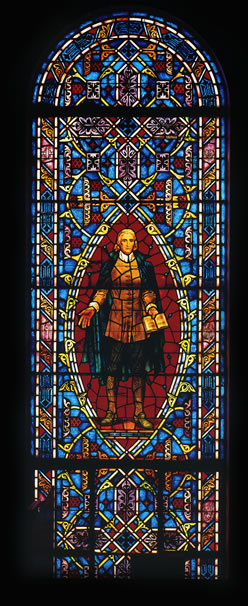
George Fox, founder of the Quaker Society, was born in Drayton in 1624. He began an itinerant, lifelong ministry in 1647, interrupted only by periods of imprisonment.
Fox’s ministry was a reaction against the formalities and deadness of contemporary Christianity. His main emphases were the importance of repentance and personal striving for truth. He insisted on an inward spiritual experience, a revelation to many people in his day. Careful attention was given to caring for the poor and building up a Quaker community offering freedom of expression and service.
In 1669, Fox married Margaret Fell, a widow who had helped him by opening her house for worship services and contributing greatly to his work.
The Quaker name was given to his followers because of the physical symptoms accompanying the emotional appeal to the conscience. It designated one who “quaked” under the conviction of sin, and the early Quakers asserted that those who did not know the quaking or trembling did not know the experience of Moses and David or the saints of the past. Often, the Quakers were in trouble with the civil authorities because they did not pay tithes to the established church nor did they take oaths.
During the 18th century, the doctrine of the inward light acquired exclusive prominence, and the written scriptures were considered outward and non-essential. The Quakers, now called the Society of Friends, are best known for their emphasis on the inner light and their social service.
Fox’s last years were spent in and around London visiting Quaker meetings and families, promoting the establishment of schools, and taking part in framing the famous Toleration Act.
The left side border symbols of the Fox window, numbered from top to bottom, are: 1. a Jerusalem cross, also called a “Crusader Cross,” with four adjacent Greek crosses representing the four Gospels that replaced the law, marked by four tau-shaped crosses; 2. a pointed arch symbolizing aspiration and striving for growth in the spiritual life; and 3. the shield of St. Matthew with three purses referring to his early occupation as a tax gatherer.
The right side border symbols of the Fox window, numbered from top to bottom, are: 1. three circles symbolizing the Holy Trinity; 2. a seven-tongued flame representing the Holy Spirit during Pentecost; 3. a dove and an olive branch, symbols from the story of Noah and the Deluge, indicating the storm had passed, the waters subsided, and, thus, peace with mankind was restored.
There is no aisle window beneath George Fox’s clerestory image because there is no record of Fox either attending college or teaching in one.














